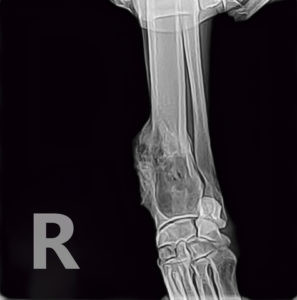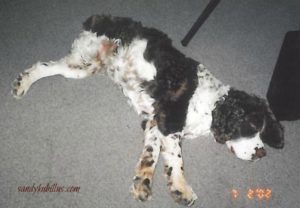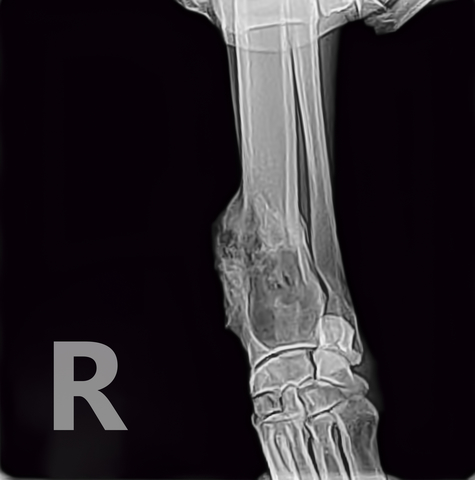At some point, all dogs limp, but usually only for a short time. First, you check your dog for an injury like a thorn in the paw or a sore joint. If you don’t find an immediate problem, then often you decide to restrict exercise and see if he gets better in a day or two. After a few days of seeing no improvement, you take him to the vet.
This part is critical since I’ve had several misdiagnoses from veterinarians. Often, when checking an older dog, the vet will diagnose arthritis and prescribe an anti-inflammatory drug. This could waste weeks of time while you wait for your dog to show improvement from the drugs, while a tumor could be growing.

If your dog has had a bone injury in the past, such as a broken bone, implant, bone infection or other predisposing factors—insist on an x-ray of the affected limb. My vet didn’t take an x-ray until several months after my 8-year-old springer spaniel, Kaylee, started limping.
Never be afraid to get a second opinion from another veterinarian or specialist.
Causes
Osteosarcoma typically occurs in the limbs, although it can occur in the ribs and skull. It frequently occurs near growth plates and is often associated with areas of rapidly growing bone, such as the site of an old fracture, as well as near foreign bodies such as metal implants, bullets, and bone transplants.
Osteosarcoma typically occurs in older dogs with the average age of 7. The large size of some breeds and heredity may play a roll.
Types
Osteosarcoma is the most common and aggressive form of bone cancer, resulting in 75 – 85% of all bone cancers and 5% of all types of canine tumors. Other forms of bone cancer include fibrosarcoma and chondrosarcoma, both of which are not very aggressive.
Symptoms
Typical symptoms involve limping and swelling at the tumor site. Micro-fractures or pathologic fractures (a fracture caused from a minor injury) are typically the cause of lameness. These types of fractures do not heal. Lameness can come on suddenly or start slowly and intermittently over several weeks.
Osteosarcoma in the jaw causes difficulty in swallowing. Skull or vertebrate tumors cause neurologic deficits, and pelvic tumors may cause the dog to have difficulty defecating.
Pain may cause the dog to refuse exercise, show loss of appetite, irritability, aggression, weight loss, sleeplessness, and whimpering.
By the time the dog shows lameness, osteosarcoma has often metastasized. It often spreads to the lungs and other bones, but sometimes to the lymph nodes.
Diagnosis
Diagnosis is usually with an x-ray. If it is not clear on the x-ray, the vet may want to do a biopsy. My veterinarian said the x-ray was clear and a biopsy would cause trauma to the dog and would delay action, possibly letting the cancer spread farther.
The veterinarian may want to x-ray the chest to see if the cancer has spread. The absence of tumors in the chest may not mean it hasn’t spread, since 90% of osteosarcomas have metastasized by the time of diagnosis. But often the tumors are too small to observe.
Treatments
Amputation of the affected limb is the standard treatment. This can result in removal of the disease if it hasn’t metastasized into other areas. Although amputation seems drastic, Kaylee could walk within a few days after surgery and seemed relatively free of pain, while before the surgery she didn’t want to leave her bed.

Replacement of the diseased bone with a bone graft or metal implant is another option (limb sparing). But my experience with a bone graft when Kaylee broke her femur into five pieces was that it took a very long time to heal and required multiple surgeries. If the osteosarcoma has spread, the dog may not live long enough to fully recover from a bone graft.
Chemotherapy usually begins several weeks after surgery. The typical regime is 4 – 6 treatments, 3 weeks apart. Dogs do not get as sick from chemotherapy as people do since lighter doses are given. Their fur does not fall out, but it may thin after multiple treatments.
Radiation treatments may shrink the tumor, and are used where amputation is not feasible.
Check with veterinary hospitals for experimental studies and new drugs. The book Heal: The Vital Role of Dogs in the Search for Cancer Cures discusses several new promising drugs and studies that have occurred with dogs and osteosarcoma.
Prognosis
The prognosis for osteosarcoma is usually not good. For dogs receiving amputation but no chemotherapy, survival times are only a few months. With chemotherapy, the prognosis averages about a year, but up to 28% survive up to two years. Senior dogs between the ages of 7 to 10 tend to survive longer than younger and older dogs.
With Kaylee, I opted for amputation only. In 2002, my options were limited with chemotherapy and reports at that time stated that chemotherapy typically only extended the dog’s life by a few months. Chemotherapy was also very costly. Kaylee survived for exactly 24 months from the time she started limping. But she developed paralysis in her remaining back leg and throughout much of her trunk muscles for the last year of her life. Check out my page on Kaylee for more information.
Please let me know your experiences by leaving a comment below, emailing me at Sandy@Caninecancerconcerns.com, or go to my contact page.
http://wearethecure.org/learn-more-about-canince-cancer/canine-cancer-library/osteosarcoma/
http://www.caninecancer.com/osteosarcoma
https://www.pets4homes.co.uk/pet-advice/canine-bone-cancers-understanding-the-different-types.html

